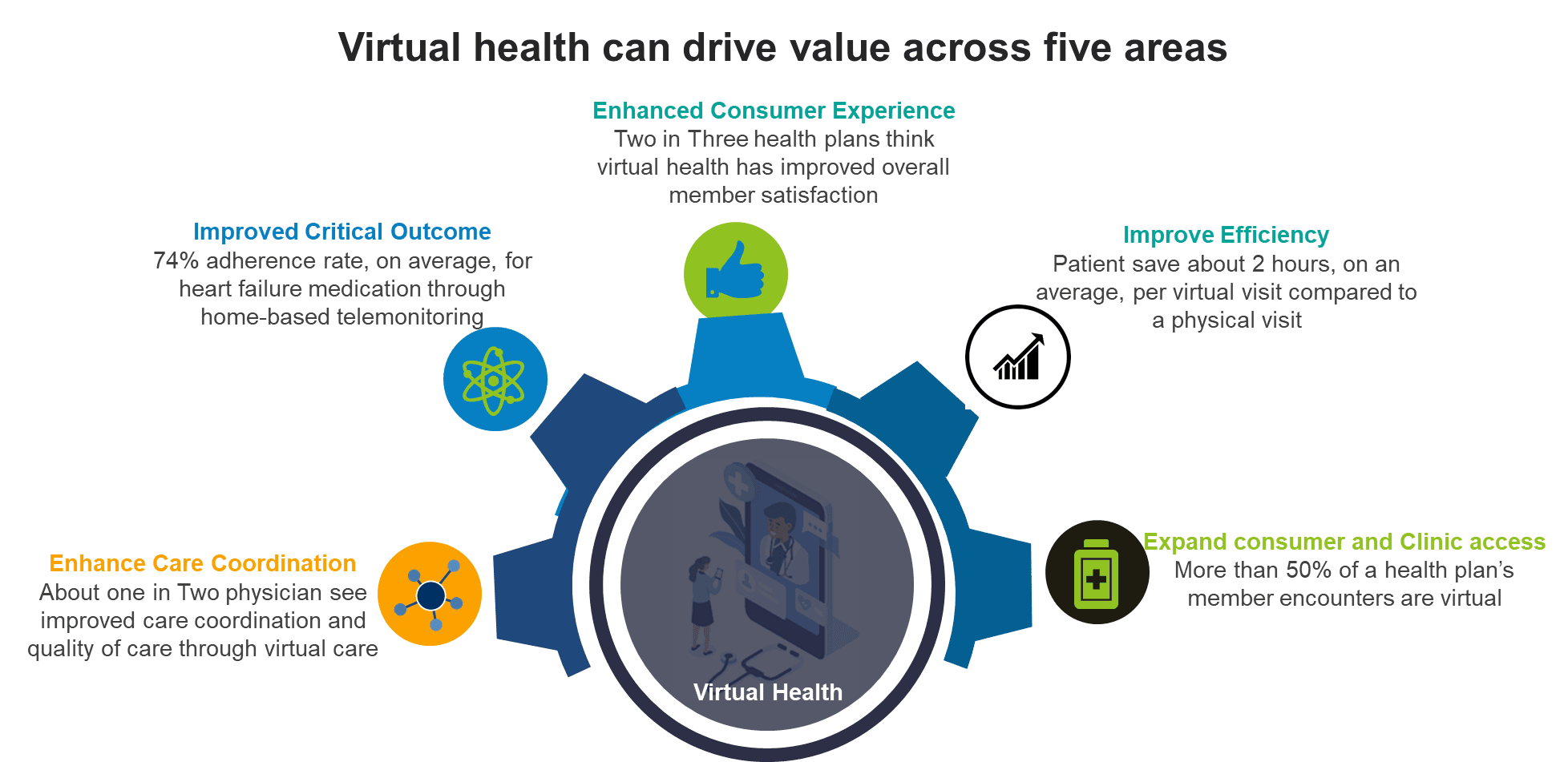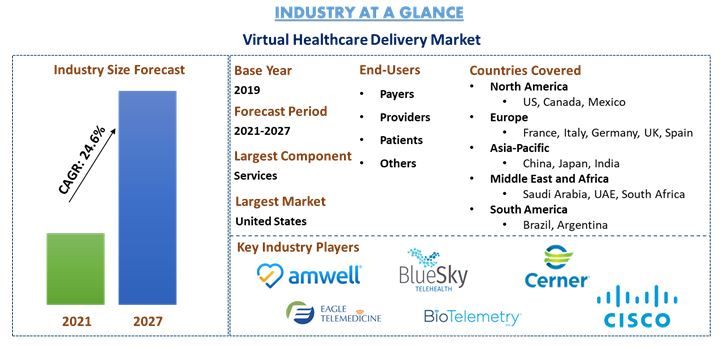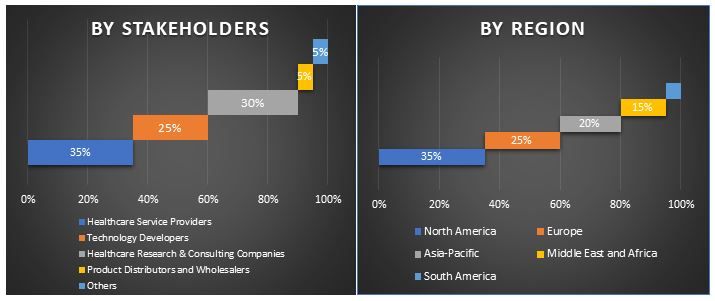- Home
- About Us
- Industry
- Services
- Reading
- Contact Us
Virtual Healthcare Delivery Market: Current Analysis and Forecast (2020-2027)
Emphasis on Platform Type (Video Consultation, Audio Consultation, Messaging, Kiosks), Components (Solutions, Services), Delivery Mode (Web/Telephonic, Call Centers), Specialty (Cardiology, Radiology, Psychiatry, Urgent Care, Remote ICU, Dermatology, Others), End-users (Payers, Providers, Patients, Others) and Region/Country
The global virtual healthcare delivery market was valued at US$ 21 billion in 2019 and is projected to expand significantly with a CAGR of 24.6% from 2021 to 2027. Surging internet penetration coupled with the rising adoption of smartphones across the globe is one the key contributing factor for the growth in the virtual healthcare delivery market. As per the world bank in 2015 around 41% of the global population was internet users which increased to 48.99% in 2017. Further, internet users based reached 4.39 billion in 2019. The virtual healthcare delivery market is witnessing an uptick on account of the benefits such as no cost of -person visits, accessibility of the rural areas’ resident to the good healthcare service provider, Increased Patient Engagement, Better Patient Care Quality, etc. Moreover, the rising global aging population coupled with the need for preventive and precautionary measures is acting as a growth catalyst to the industry.
The IT investments healthcare sector and advancement of technologies that helps in facilitating health care providers to connect with patients and consulting practitioners across extensive distances and the saves time and travel of the patient is a leading factor for the market rise. As per a study by Cisco, globally more than 74% of Consumers are open to virtual doctor visits. Furthermore, due to the offering of services such as video consultation, audio consultation, etc., as per the patients’ requirement and comfort by the players in the end-users are gaining traction on the adoption of virtual healthcare delivery.
Also, the COVID-19 pandemic gave a robust boom to the virtual healthcare delivery market. The market registered an exhibit growth in the number of patients for a virtual consultation. Moreover, governments across the countries such as the U.S, Canada, India, etc. announced and launched several portals for a virtual consultation. As per a health-tech platform Practo, the company registered 500% growth in the online consultation from March to May in 2020.
Worldwide Share of Deaths, by Cause

The global Virtual Healthcare Delivery market is highly fragmented. The presence of numerous global and local players across regions makes the industry highly competitive. The key players with a considerable market share in the industry are Allscripts Healthcare Solution, American Well, Biotelemetry, Blue Sky Telehealth, Cisco Systems, Honeywell International, McKesson Corporation, OBS Medical, SOC Telemed, MDLIVE, Inc., and AMD Global Telemedicine among others. Several M&A’s along with partnerships have been undertaken by these players to facilitate costumers with hi-tech and innovative products.
Insights Presented in the Report
“Amongst Platform Type, Video Consulting segment holds the major share”
Based on platform type, the market is fragmented into Video consultation, Audio consultation, Messaging, and KIOSKS. Video consultation type dominated the market with a share of 52% in 2019 and is expected to maintain its dominance during the forecast period owing to the busy lifestyle and time-saving factor of video conferencing. However, the KIOSKS would witness steady growth in the forecast period on account of the new solutions by the key players in the industry for KIOSKS.
“Amongst Components Type, Services is expected to dominate the market during the analyzed period”
Based on the market segment by components, the market is segmented into software and services. In 2019, the services segment captured more than 50% of the market share. The market is witnessing an uptick due to the adoption of new technologies that require professional and managed services. However, the demand for solutions is expected to emerge from developing countries.
“Amongst Delivery Mode Type, Web/ Telephonic segment is expected to dominate the market during the analyzed period”
Based on Delivery mode type, the market is fragmented into Web/ Telephonic segments. Web/Telephonic segment being an old and mature technology grabbed the major market share in 2019. Moreover, escalating internet penetration and offering of mobile data at an affordable price is also a contributing factor for market growth.
“Amongst Specialty Type, Cardiology segment grabbed the major market share”
Based on specialty type, the market is fragmented into Cardiology, Radiology, Psychiatry, Urgent Care, Remote ICU, Dermatology, and others. The Cardiology segment captured the leading market share and contributed around 19.38% in 2019 owing to the surging prevalence of CVDs across the globe due to unhealthy lifestyles and changes in dietary habits. However, the Neurology segment is forecasted to grow at a considerable CAGR in the forthcoming years.
“North America represents one of the largest markets of Virtual Healthcare Delivery market”
For a better understanding of the market dynamics of the virtual healthcare delivery market, a detailed analysis was conducted for different regions across the globe including North America (the U.S, Canada, Mexico), Europe (Germany, France, Italy, United Kingdom, Spain and Rest of Europe), Asia-Pacific (China, Japan, India, and Rest of APAC), Middle East and Africa (UAE, Saudi Arabia, South Africa and Rest of MEA), South America (Brazil, Argentina) has been conducted. North America dominated the market and generated revenue of US$ 9.4 billion in 2019 owing to the presence of well establishes healthcare infrastructure, Moreover, the surging healthcare IT investment in the region coupled with the presence of well-established players and the latest technology upgraded products and services make the region dominant.
Reasons to buy this report:
- The study includes market sizing and forecasting analysis validated by authenticated key industry experts
- The report presents a quick review of overall industry performance at one glance
- The report covers an in-depth analysis of prominent industry peers with a primary focus on key business financials, product portfolio, expansion strategies, and recent developments
- Detailed examination of drivers, restraints, key trends, and opportunities prevailing in the industry
- The study comprehensively covers the market across different segments
- Deep dive regional level analysis of the industry
Customization Options:
The Virtual Healthcare Delivery Market can further be customized as per the requirement or any other market segment. Besides this, UMI understands that you may have your own business needs, hence feel free to connect with us to get a report that completely suits your requirements.
Table of Content
Analyzing the historical market, estimation of the current market, and forecasting the future market of the Global Virtual Healthcare Delivery Market were the three major steps undertaken to create and analyze the adoption of Virtual Healthcare Delivery across various industry verticals in major regions globally. Exhaustive secondary research was conducted to collect the historical market numbers and estimate the current market size. Secondly, to validate these insights, numerous findings and assumptions were taken into consideration. Moreover, exhaustive primary interviews were also conducted, with industry experts across the value chain of Virtual Healthcare Delivery. Post assumption and validation of market numbers through primary interviews, we employed a top-down approach to forecasting the complete market size. Thereafter, market breakdown and data triangulation methods were adopted to estimate and analyze the market size of segments and sub-segments the industry pertains to. Detailed methodology is explained below:
Analysis of Historical Market Size
Step 1: In-Depth Study of Secondary Sources:
Detail secondary study was conducted to obtain the historical market size of the Virtual Healthcare Delivery through company internal sources such as annual report & financial statements, performance presentations, press releases, etc., and external sources including journals, news & articles, government publications, competitor publications, sector reports, third-party database, and other credible publications.
Step 2: Market Segmentation:
After obtaining the historical market size of the Virtual Healthcare Delivery, we conducted a detailed secondary analysis to gather historical market insights and share for different segments & sub-segments for major regions. Major segments included in the report as type and subtypes. Further country-level analyses were conducted to evaluate the overall adoption of Virtual Healthcare Delivery in that region.
Step 3: Factor Analysis:
After acquiring the historical market size of different segments and sub-segments, we conducted a detailed factor analysis to estimate the current market size of Virtual Healthcare Delivery. Further, we conducted factor analysis using dependent and independent variables such as the growth of the healthcare IT industry, surging prevalence of diseases, Investments, etc. A thorough analysis was conducted for demand and supply-side scenario considering top partnerships, merger and acquisition, business expansion, and product launches in the Virtual Healthcare Delivery sector across the globe.
Current Market Size Estimate & Forecast
Current Market Sizing: Based on actionable insights from the above 3 steps, we arrived at the current market size, key players in the Virtual Healthcare Delivery market, and market shares of the segments. All the required percentage shares split, and market breakdowns were determined using the above-mentioned secondary approach and were verified through primary interviews.
Estimation & Forecasting: For market estimation and forecast, weights were assigned to different factors including drivers & trends, restraints, and opportunities available for the stakeholders. After analyzing these factors, relevant forecasting techniques i.e. top-down approach was applied to arrive at the market forecast about 2027 for different segments and subsegments across the major markets globally. The research methodology adopted to estimate the market size encompasses:
- The industry’s market size, in terms of value (US$) and the adoption rate of Virtual Healthcare Delivery across the major markets domestically
- All percentage shares, splits, and breakdowns of market segments and sub-segments
- Key players in the Virtual Healthcare Delivery market in terms of services offered. Also, the growth strategies adopted by these players to compete in the fast-growing market
Market Size and Share Validation
Primary Research: In-depth interviews were conducted with the Key Opinion Leaders (KOLs) including Top Level Executives (CXO/VPs, Sales Head, Marketing Head, Operational Head, and Regional Head, Country Head, etc.) across major regions. Primary research findings were then summarized, and statistical analysis was performed to prove the stated hypothesis. Inputs from primary research were consolidated with secondary findings, hence turning information into actionable insights.
Split of Primary Participants in Different Regions
Market Engineering
Data triangulation technique was employed to complete the overall market estimation and to arrive at precise statistical numbers of each segment and sub-segment of the Virtual Healthcare Delivery market. Data were split into segments such as Platform Type, Components, Delivery Mode, Specialty, and End-user post studying various parameters and trends in the areas of type and their type of the Virtual Healthcare Delivery market.
The main objective of the Virtual Healthcare Delivery Market Study
The current & future market trends of Virtual Healthcare Delivery were pinpointed in the study. Investors can gain strategic insights to base their discretion for investments from the qualitative and quantitative analysis performed in the study. Current and future market trends were determined the overall attractiveness of the market at a regional level, providing a platform for the industrial participant to exploit the untapped market to benefit as a first-mover advantage. Other quantitative goals of the studies include:
- Analyze the current and forecast market size of Virtual Healthcare Delivery in terms of value (US$). Also, analyze the current and forecast market size of different segments and sub-segments
- Segments in the study include areas of type and their subtypes
- Define and analysis of the regulatory framework for the Virtual Healthcare Delivery industry
- Analyze the value chain involved with the presence of various intermediaries, along with analyzing customer and competitor behaviors of the industry
- Analyze the current and forecast market size of the virtual healthcare delivery market for the major region
- Major regions studied in the report include North America (the U.S and Canada), Europe (Germany, France, Italy, Spain, and United Kingdom), Asia-Pacific (China, Japan, and India), Middle East and Africa (UAE, Saudi Arabia, and South Africa) and South America (Brazil, Argentina)
- Company profiles of the Virtual Healthcare Delivery market and the growth strategies adopted by the market players to sustain in the fast-growing market
- Deep dive regional level analysis of the industry
Related Reports
Customers who bought this item also bought












